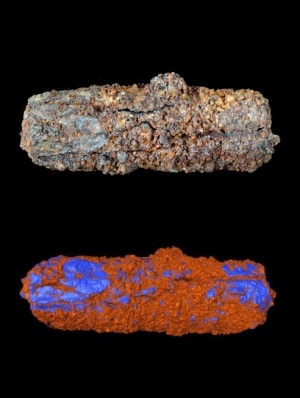.
Meteorite impacts thousands of years ago may have helped to inspire ancient religion.
Nickel-rich areas are colored blue on a virtual model (bottom) of the Gerzeh bead.
.
The 5,000-year-old iron bead might not look like much, but it hides a spectacular past: researchers have found that the ancient Egyptian trinket is made from a meteorite.
The result, published on 20 May in the journal Meteoritics & Planetary Science1, explains how ancient Egyptians obtained iron millennia before the earliest evidence of iron smelting in the region, solving an enduring mystery. It also hints that the ancient Egyptians regarded meteorites highly as they began to develop their religion.
“The sky was very important to the ancient Egyptians,” says Joyce Tyldesley, an Egyptologist at the University of Manchester, UK, and a co-author on the paper. “Something that falls from the sky is going to be considered as a gift from the gods.”
An early study found that the iron in the beads had a high nickel content — a signature of iron meteorites — and led to the suggestion that it was of celestial origin2. But scholars argued in the 1980s that accidental early smelting efforts could have led to nickel-enriched iron3, while a more recent analysis of oxidised material on the surface of the beads showed low nickel content4.
To settle the argument, Diane Johnson, a meteorite scientist at the Open University in Milton Keynes, UK, and her colleagues used scanning electron microscopy and computed tomography to analyze one of the beads on loan from the Manchester Museum, UK.
The researchers weren't able to cut the precious artefact open, but they found areas where the weathered material on the surface of the bead had fallen away, providing what Johnson describes as "little windows" to the preserved metal beneath.
The nickel content of this original metal was high — 30% — suggesting that it did indeed come from a meteorite. To confirm the result, the team observed a distinctive crystallographic structure called a Widmanstätten pattern. It is only found in iron meteorites, which cooled extremely slowly inside their parent asteroids as the Solar System was forming.
The tomography analysis also revealed that the ancient Egyptians hammered a fragment of iron from the meteorite into a thin plate before they bent it into a tube.
Gifts from the gods
Researchers have discovered only a handful of ancient Egyptian iron artefacts made before the sixth century BC, when the first evidence for iron smelting in ancient Egypt appears in the archaeological record. All come from high status graves such as that of King Tutankhamun. "Iron was very strongly associated with royalty and power," says Johnson.
Objects made of such divine material were believed to guarantee their deceased owner priority passage into the afterlife.
Campbell Price, a curator of Egypt and Sudan at the Manchester Museum who was not a member of the study team, emphasizes that nothing is known for certain about the Egyptians’ religious beliefs before the advent of writing. But he points out that later on, during the time of the Pharaohs, the gods were believed to have bones made of iron.
Perhaps meteorites originally inspired this belief, he speculates, with these celestial rocks interpreted as the physical remains of gods falling to Earth.
Johnson says she would love to check whether other early Egyptian iron artefacts are of meteoritic origin too — if she can get permission to study them.
Quelle: Nature

